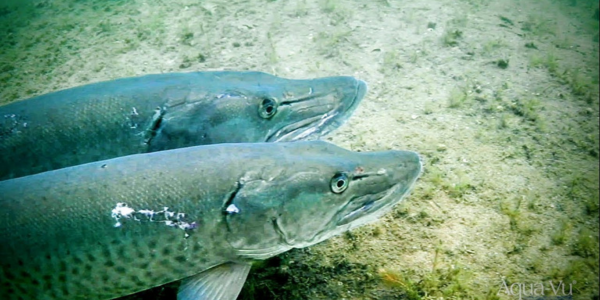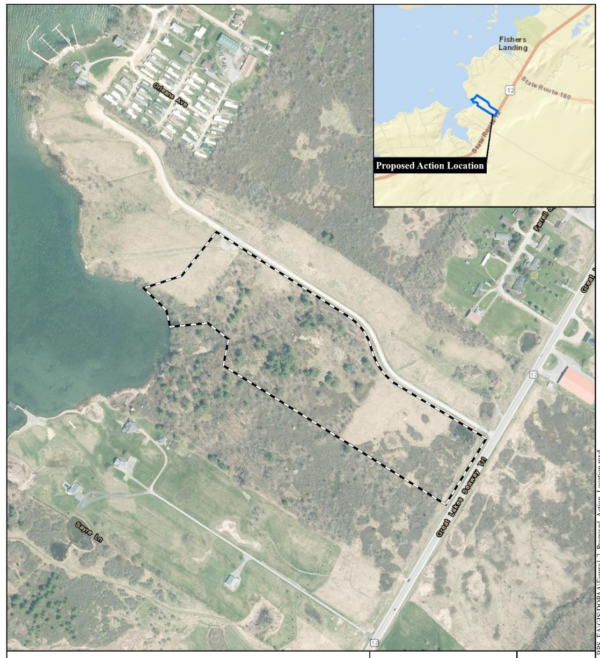About Blind Bay
Blind Bay is an environmental treasure and has open and protected wetland areas. It has served as a long-term aquatic habitat research site monitored by the Thousand Islands Biological Station (TIBS) and has been documented as one of the most prolific muskellunge spawning areas in the Thousand Islands. TIBS has monitored Blind Bay since 1990 and documented that the St. Lawrence River muskellunge have experienced a significant and recent decline due to losses associated with viral hemorrhagic septicemia (VHS) and habitat degradation. Maintenance of high-quality spawning and nursery habitat is critical to ensuring population recovery and sustainability.
Other important fish species at the site are small and largemouth bass, northern pike, yellow perch, black crappie, bluegill, pumpkinseed, and bullhead; 53 fish species have been recorded at this location. In 2021, seining conducted by TIBS captured young-of-year muskellunge, northern pike, large and smallmouth bass, as well as NYS endangered pugnose shiner. Other NYS Species of Concern and Species of Conservation Need in the Blind Bay record include: American eel; blackchin, blacknose, and bridle shiner; Eastern musk turtle, and map turtle.
U.S. Customs and Border Protection (CBP) is proposing a new Border Patrol facility in Blind Bay
The proposed location for this facility is currently owned and managed by the Thousand Island Land Trust (TILT).
TILT, Save The River® Upper St. Lawrence Riverkeeper®, and Coalition Partners have been planning and working tirelessly to protect this one-of-kind River ecosystem. Blind Bay continues to be one of the most prolific muskellunge spawning areas in the region.

CBP's Industrial-Scale Proposal

In February 2022 the U.S. Department of Homeland Security released Draft Environmental Assessment for the proposed location of the new facility.
“INTRODUCTION: United States (U.S.) Customs and Border Protection (CBP) prepared an Environmental Assessment (EA) that addresses the potential effects, beneficial and adverse, resulting from the proposed construction and operation of a new Border Patrol Station (BPS) in the U.S. Border Patrol (USBP) Buffalo Sector, Wellesley Island Station Area of Responsibility (AOR), Orleans, New York. Click here to view the entire draft environmental assessment for this project.
In a letter to the Town of Orleans Zoning Officer, U.S. Customs & Border Protection outlined:
That the proposed facility would consist of approximately 48,000 square feet of building space, detention center, an impermeable parking lot for up to 100 vehicles, canine facility, marine storage, boat ramp/docks, car wash, fuel depot, communication towers, perimeter fencing and high-intensity lighting. The industrial-scale facility will accommodate up to 75 agents and enable future expansion.
OUR Position
Why are we opposed to this location for the new facility?
Blind Bay has been one of the most prolific muskellunge spawning areas in the region and has been monitored since 1990. St. Lawrence River muskellunge have experienced a significant and recent decline due to losses associated with viral hemorrhagic septicemia (VHS) and habitat degradation.
Maintenance of high quality spawning and nursery habitat is critical to ensuring population recovery and sustainability. Other important fish species at the site are small and largemouth bass, northern pike, yellow perch, black crappie, bluegill, pumpkinseed, and bullhead; 53 fish species have been recorded at this location.
Riparian vegetation known to protect shorelines in storm events and serve as critical habitat for birds will be destroyed. Sensitive birds that use this area will receive frequent disturbance. Bald Eagle, Green Heron, Great Blue Heron, Osprey, Belted Kingfisher, and waterfowl species are known to roost and feed in this area. There may be numerous other species impacted including secretive marsh birds.
The Thousand Islands and the St. Lawrence River Valley are located in the heart of the Frontenac Arch Wildway, creating an intersection that marks one of the highest levels of biological diversity in North America. Habitat fragmentation, land use changes, and physical barriers, such as high fences, could forever alter the future of this unique landscape.
Instead of flood mitigation and water filtration, there would be increased runoff and detrimental impacts to near-shore water quality. This concern is further compounded by the risks of hazardous soil and water contaminations from on-site fuel storage and parking facilities. Dredging for the proposed boat ramps and dock system would likely disturb residual contaminates on the River bottom.
The proposed Border Patrol facility would not only eliminate the proposed site as natural open space, but it would directly impact the ecosystem services and economic benefits provided by TILT’s adjacent preserve. Siting the facility in a marine residential area will have direct impact on the property values of homes along the mainland waterfront and the many nearby islands, including Wellesley Island.
The facility will be directly in the line of sight of Thousand Islands Park and will be lit 365 nights per year. The Blind Bay site is zoned Rural Residential. Thousand Islands Park relies on the town’s zoning to protect it from inappropriate development. And the plan conflicts with the Town of Orleans recently completed Comprehensive Plan and Local Waterfront Revitalization Plan.
Thousand Islands Land Trust
135 John Street
Clayton, NY 13624
315-686-5345
info@tilandtrust.org





